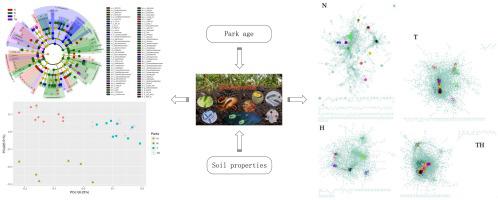当前位置:
X-MOL 学术
›
Pedobiologia
›
论文详情
Our official English website, www.x-mol.net, welcomes your
feedback! (Note: you will need to create a separate account there.)
Composition and interaction frequencies in soil bacterial communities change in association with urban park age in Beijing
Pedobiologia ( IF 2.0 ) Pub Date : 2021-02-01 , DOI: 10.1016/j.pedobi.2020.150699 Bing Yan , Qing Lu , Jing He , Yue Qi , Gang Fu , Nengwen Xiao , Junsheng Li
Pedobiologia ( IF 2.0 ) Pub Date : 2021-02-01 , DOI: 10.1016/j.pedobi.2020.150699 Bing Yan , Qing Lu , Jing He , Yue Qi , Gang Fu , Nengwen Xiao , Junsheng Li

|
Abstract Soil microbes play an important role in pollutant remediation and nutrient cycling in urban green spaces. However, how microbial composition and diversity are affected by environmental factors is poorly understood. Here, we compared soil microbial communities in 11 urban parks, constructed at different times (10, ∼30 and >100 years ago) or existing in their natural state. The dominant phyla in the samples were Proteobacteria, Bacteroidetes, Actinobacteria, Gemmatimonadetes, Verrucomicrobia, and Planctomycetes. The relative abundance of some phyla showed significant differences between natural forest parks and urban parks. Park construction over a period of time led to significant differences in microbial community structure, which was also significantly correlated with soil pH, moisture, total nitrogen, total carbon, and soil bulk density. Bacterial diversity was significantly positively correlated with pH, and species diversity was not significantly different in each successive park age category. Co-occurrence network analysis revealed that microbial guilds in urban soils were well correlated. Abundant soil microbes in natural forests and hundred-year-old parks had fewer interactions, while abundant bacteria in ten-year-old and thirty-year-old park soils had more interactions. Our results indicate the influence of urban park ages on soil microbial communities, which is important for understanding the effect of urbanization on soil microbes.
更新日期:2021-02-01











































 京公网安备 11010802027423号
京公网安备 11010802027423号